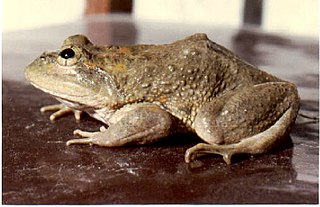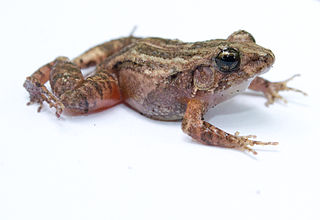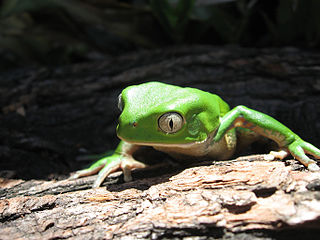 W
WChiasmocleis albopunctata is a species of frog in the family Microhylidae. It is found in Bolivia, Brazil, and Paraguay. Its natural habitats are subtropical or tropical dry forests, dry savanna, moist savanna, subtropical or tropical moist shrubland, subtropical or tropical seasonally wet or flooded lowland grassland, intermittent freshwater lakes, intermittent freshwater marshes, arable land, pastureland, rural gardens, heavily degraded former forest, ponds, seasonally flooded agricultural land, and canals and ditches.
 W
WChrysopaa is a genus of frogs in the family Dicroglossidae. It is monotypic, being represented by the single species, Chrysopaa sternosignata. It is found in Balochistan, Pakistan, Kashmir and in Afghanistan. Its common names include Baluch Mountain frog, karez frog, Malir paa frog, and Murray's frog.
 W
WCraugastor bransfordii is a species of frog in the family Craugastoridae. It is found in Costa Rica, Nicaragua, and Panama. Its natural habitats are subtropical or tropical moist lowland forests and subtropical or tropical moist montane forests. It is threatened by habitat loss.
 W
WCraugastor polyptychus is a species of frog in the family Craugastoridae. It is found in Costa Rica, Nicaragua, and Panama. Its natural habitats are subtropical or tropical moist lowland forests, plantations, rural gardens, and heavily degraded former forest. It is threatened by habitat loss.
 W
WDermatonotus is a genus of frogs in the family Microhylidae. It is monotypic, being represented by the single species, Dermatonotus muelleri, commonly known as Muller's termite frog. It is found in Argentina, Bolivia, Brazil, and Paraguay.
 W
WEleutherodactylus verrucipes is a species of frog in the family Eleutherodactylidae. It is endemic to Mexico. Its natural habitats are subtropical or tropical moist lowland forests and subtropical or tropical moist montane forests. It is threatened by habitat loss.
 W
WLeptobrachium montanum is a species of frog from the family Megophryidae. It is endemic to Borneo and is, as currently defined, found in Kalimantan (Indonesia), Sabah and Sarawak (Malaysia), and Labi, Belait (Brunei). However, the nominal Leptobrachium montanum is a composed of more than one lineage. Available information mostly refers to this composite rather than the "true" Leptobrachium montanum. Common names montane large-eyed litter frog, mountain spadefoot toad, and mountain litter frog have been coined for it.
 W
WThe long-legged wood frog, also known as Caucasus frog, or Uludağ frog, is a species of frog in the family Ranidae found in Armenia, Azerbaijan, Georgia, Iran, Russia, Turkey, and Turkmenistan. Its natural habitats are boreal forests, temperate forests, temperate shrubland, subtropical or tropical dry shrubland, temperate grassland, rivers, intermittent rivers, swamps, freshwater lakes, intermittent freshwater lakes, freshwater marshes, intermittent freshwater marshes, freshwater springs, rocky areas, arable land, pastureland, plantations, rural gardens, urban areas, water storage areas, ponds, and introduced vegetation. It is not considered threatened by the IUCN.
 W
WThe near Eastern fire salamander, in Arabic arouss al-ayn, is a species of salamander in the family Salamandridae found in Iran, Iraq, Turkey, Syria, Lebanon, and Israel. Its natural habitats are subtropical dry shrubland and forests, often near rivers and freshwater springs. It is threatened by habitat loss.
 W
WThe Nicaragua cross-banded tree frog or tawny smilisca, Smilisca puma, is a species of tree frog in the family Hylidae. It is found in the Caribbean lowlands of Costa Rica and adjacent Nicaragua to about 520 m (1,710 ft) above sea level. Its natural habitats are tropical moist lowland forests. It breeds in small, shallow temporary pools or ponds, including those in very disturbed habitats, such as pastures. Males call during the rainy season from shallow water and low bushes. Habitat loss and degradation caused by small- and large-scale agriculture and logging are threats to this species.
 W
WThe Perez's frog, also known as Iberian waterfrog, Iberian green frog, or Coruna frog is a species of frog in the family Ranidae. It is native to southern France, Portugal, Spain, and has been introduced to the Canary and Balearic Islands, Madeira, the United Kingdom, and the Azores; in the Iberian Peninsula it is widespread and common, as evidenced by its Spanish name rana común.
 W
WPhyllomedusa iheringii is a species of frog in the family Phyllomedusidae, found in Brazil and Uruguay. Its natural habitats are temperate shrubland and intermittent freshwater marshes, and is threatened by habitat loss.